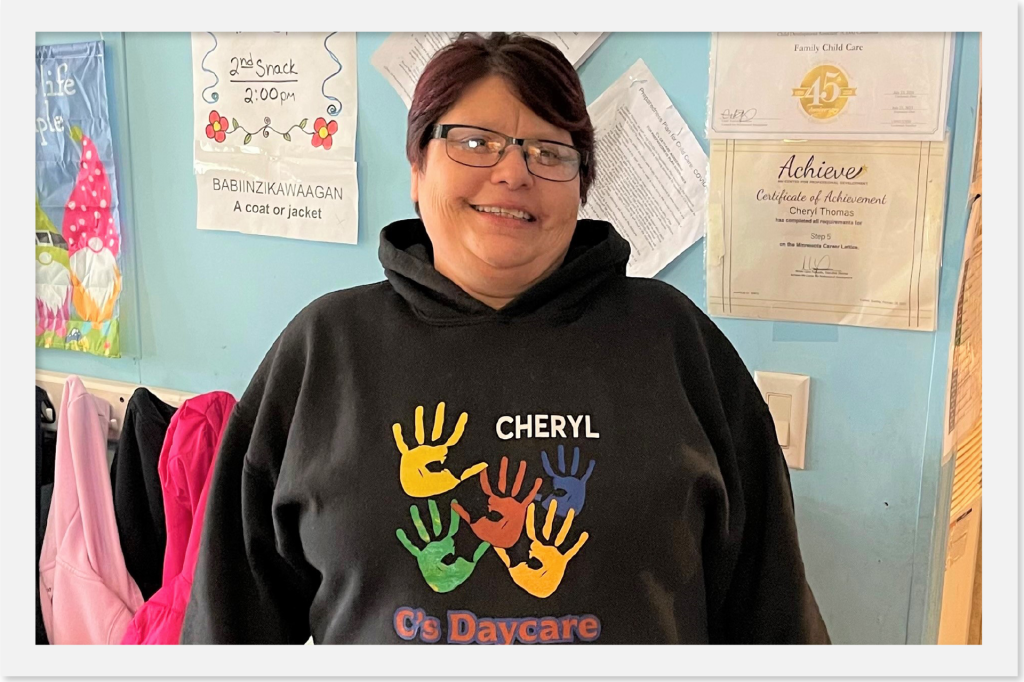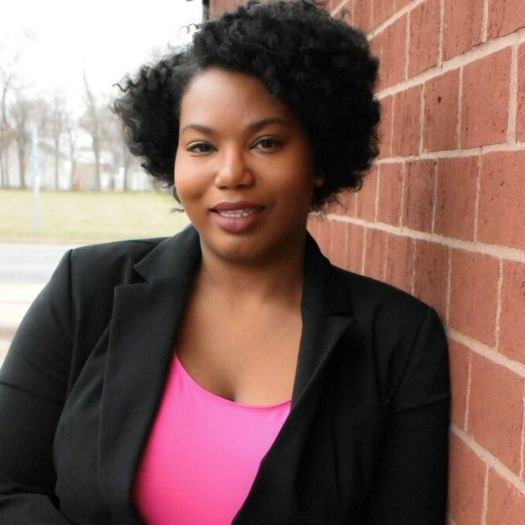
Top image: Cheryl Thomas, founder of C’s Daycare in the Red Lake Nation of northern Minnesota
A safe place to learn
“I offer a safe place for my kids. They have structure and stability,” said Cheryl Thomas, founder and owner of C’s Daycare, 30 miles north of Bemidji, Minnesota. It’s one of the few licensed child care facilities in the Red Lake Nation, tribal lands of the Ojibwe (pronounced ‘Oh-jeeb-way’) people.
Thomas’s business typically provides care daily for 18-20 children, ages 6 weeks to 12 years old, and seeks to pass on Ojibwe culture and language. Children learn to greet each other in Ojibwe and to identify numbers and animals in their ancestors’ tongue.
Thomas seeks to give kids room to explore. Learning is self-paced and play based. “We turned our daycare into a yes daycare,” she said. “There’s nothing the kids can’t get into here. It’s all for them. They play, they get dirty, they do things kids are supposed to do.”
It’s a point of special pride for Thomas that C’s Daycare has stayed open throughout the COVID-19 pandemic, providing a dependable source of child care during a particularly challenging time for the reservation.

Connecting with First Children’s Finance
As a licensed child care facility, Thomas’s business already followed many sanitary measures newly-mandated because of the pandemic. With school facilities closed temporarily, a bigger challenge for Thomas and her staff was figuring out how to best assist their school-aged charges with distance learning.
For months, they helped kids from kindergarten to sixth grade attend Zoom classes and complete assignments. “During COVID all my kids had perfect attendance,” Thomas said. “I almost cried.”
Thomas’s determination to meet child care needs on the reservation was bolstered by support from First Children’s Finance (FCF).
FCF is a national nonprofit. It works to increase the supply and sustainability of child care in low- and moderate-income communities, and by their bank partners. Banks’ involvement is encouraged by the Community Reinvestment Act (CRA), a federal law that requires banks to meet credit needs throughout their service areas, including the low-income portions of them.
“During COVID all my kids had perfect attendance. I almost cried.“
Cheryl Thomas, owner, C’s Daycare
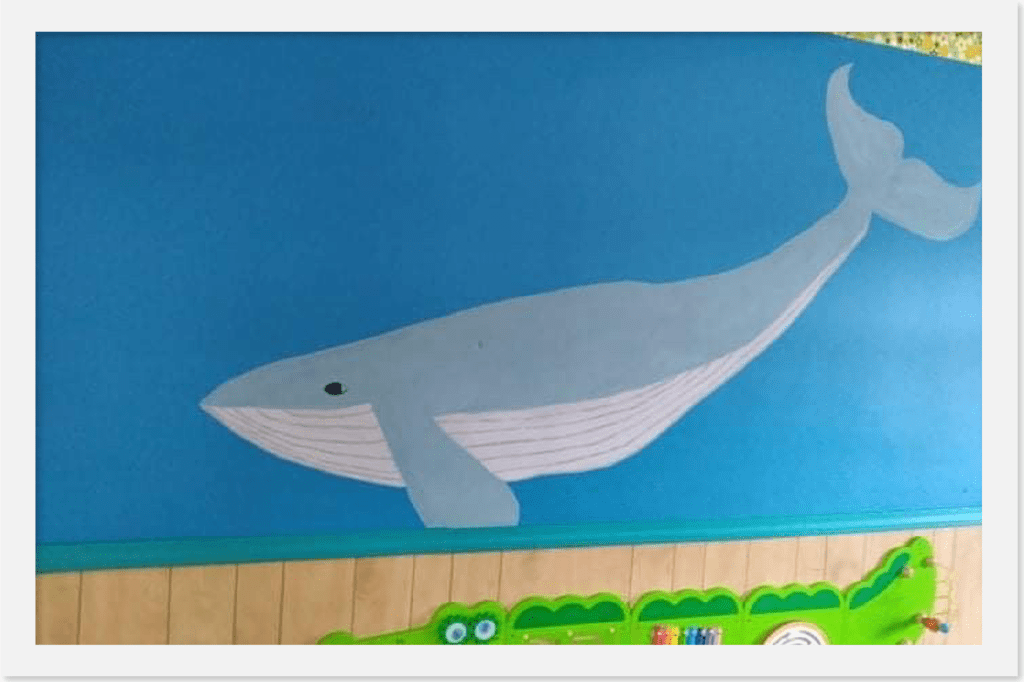

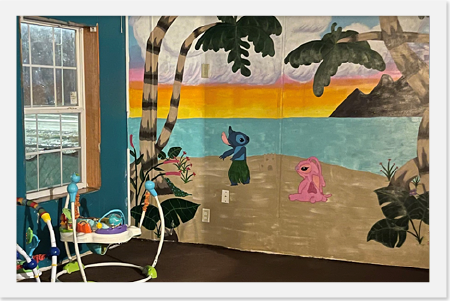
Finding help to upgrade and expand
Thomas began meeting with FCF representatives in 2019. High demand for her services had her thinking about upgrading the facility.
Openings at C’s Daycare fill almost immediately. “I usually don’t have to advertise,” Thomas said.
Thomas had several goals in mind that she thought would be achievable with a financial boost. She wanted to spruce up the property. Next, she wanted to have her facility rated by Parent Aware, Minnesota’s child care quality rating and improvement system. She wanted to expand to serve more children. Importantly, she wanted to provide additional financial aid for the low-income portion of her clientele.
In May of 2021, FCF approved C’s Daycare for a $10,000 micro loan and a $20,000 forgivable loan. The Red Lake Tribal Council provided the facility an $8,000 grant as well.
With funds in hand, Thomas began renovations.
Thomas added more useable space by putting down new flooring in a portion of the facility, replaced the refrigerator, furnace, and stove, and installed a new, bigger swing set in the outdoor play area. In the common space, Thomas quieted footfalls by putting down a large new rug.
She gave careful thought to how she wanted children to feel when they entered her building.
“We needed to create a more calming environment, so we painted rooms in different shades of blue like the ocean, with sharks, fish, jellyfish and ocean plants,” she said. “Now it looks like an aquarium.” A beach scene was added to the infants’ nursery wall.
Today, C’s Daycare boasts a 3-star rating, out of a possible 4 stars, with Parent Aware.
‘Can these people get along?’
In 1991, FCF was founded to assist child care providers like Thomas, whose businesses may be too small to qualify for conventional financing. “FCF is filling in the segment of the child care market where the alternative is small business owners’ putting $5,000 or $10,000 on a credit card,” explained Jerry Cutts, the nonprofit’s founder and CEO.
By offering advice on business practices, marketing, budgeting, and staff and client retention, FCF reinforces its financial commitments to child care providers.
“The goal is for the business to become more sustainable and be a better investment to the community.”
Ben Nicholie, CFO, First Children’s Finance
From the start, FCF sought as board members a mix of childhood experts and business people, including bankers. “At first we wondered, ‘Can these people get along? Do they have enough in common?’ It turned out they did and were excited to learn from each other,” said Cutts.
Creating the template
Bank support for FCF’s mission is crucial to the group’s ability to help entrepreneurs like Thomas.
About three years ago, as Cutts tried to figure out how to attract more funding for his organization’s work, he was introduced to Eric Britt, at the time commercial banking manager for the Minnesota operations of Old National Bank [ONB].
Britt recognized the value of his bank’s status as a correspondent bank. (A term used to denote a bank that provides services to other banks.) “We have relationships with community banks in the state,” Britt said. “We wanted to leverage what they can do.”
In 2019, Britt worked with a handful of banks to create a pooled loan fund. The banks would make loans to FCF at below-market rates. As a next step, the nonprofit could use that money to make microloans to its clients. “The challenge was creating a template that every bank could follow. Eric was instrumental in developing that template,” said Cutts.
Microlending is not cost-effective for many commercial banks. Besides, it is more efficient for ONB and other financial institutions to loan to FCF. Then FCF can underwrite small loans to child care providers since FCF knows that business well.
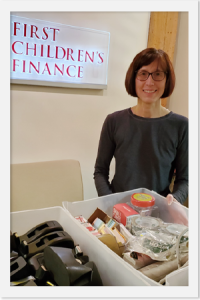
Aligning missions
Kristi Jacobson, ONB’s senior vice president of commercial banking, said FCF’s inclusion of business development support aligns with her bank’s emphasis on financial literacy in its community outreach. “We like how FCF approached child care provider clients and not only provided financing but also provided financial and business education to help them succeed,” Jacobson said.
Her colleague, Kelly Elkin, manager of government and nonprofit banking for ONB and a FCF board member, said a facility like C’s Daycare and its staff is a tool for economic mobility. She calls them “the workforce behind the workforce,” enabling parents to go to work without worrying about the safety and well-being of their children.
Partnering with FCF offers banks a dual benefit. Their financing supports development of a needed service in distressed areas while also providing banks with credit under the CRA.
Photo: Laura Riley of First Children’s Finance, accepts office supplies donated by Old National Bank.
FCF has nationwide reach and aims to expand the lending template used to fund C’s Daycare beyond Minnesota. The nonprofit would like to involve different tiers of banks—community, regional, and national—in order to gain more capital while enabling participant lenders the opportunity to boost their CRA standings.
So far the program is a success, according to Cutts. “All the community banks that invested in the pooled loan fund recently committed to renew their loan for a couple more years.”
Photo: Laura Riley (L) of FCF and Kristi Jacobson (R) of ONB, pause for a selfie after ONB’s office supply donation to FCF.
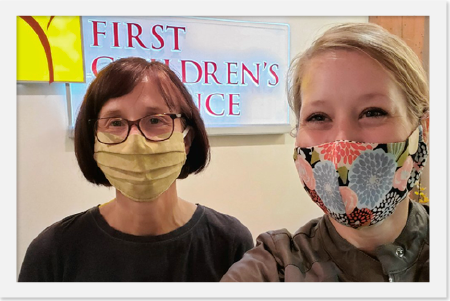
As for Thomas, she is grateful for FCF and the changes they made possible at C’s Daycare. “Every time I ride by my day care, I’m like, ‘Omigod, my new swing set looks so nice,’” she said.
CRA: Building Blocks for Change
This story is part of CRA: Building Blocks for Change. The series explores how the Community Reinvestment Act has influenced community investment and the Federal Reserve’s efforts to modernize CRA. Read more from the series >






